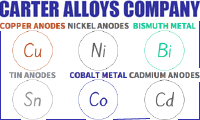
Curated with aloha by
Ted Mooney, P.E. RET

The authoritative public forum
for Metal Finishing 1989-2025

-----
Plating Oxides
2006
I was wondering if there is any way to plate oxides onto a substrate rather than plating a base metal and oxidizing the surface. I am working with a copper substrate and attempting to plate a variety of oxides directly to the surface (nickel, cobalt, bismuth, possibly titanium?) and any other metal which has an oxide that creates an optical interference layer. I will be testing these coatings for absorbtivity and thermal emissivity and will be glad to share the results.
I have already tried pre-plating and using TSP
[trisodium phosphate
⇦ this on
eBay
or
Amazon [affil links]
] in an anodizing method on cobalt with some ugly results. I know it is possible to create the coating black chrome and blue chromate, but these requires chromic acid and cause waste problems. I know it's pretty much impossible to plate TiO2, I just wanted to see if someone out there had some crazy info on the matter.
The bath I'm creating could be a dip bath but an electrolytic bath is preferred as it would only plate one side in a continuous plating line.
Plating processes involve a reduction of cations dissolved in the bath (metallic as well as hydrogen ones) onto the plated surface. The anode is a donor of electrons, the cations are attracted to the part surface where they act as receptors and get reduced to their elemental state (metal or H2). So, the straight answer to your Q is NO. Your proposed oxides would be destroyed (reduced). On the other hand, there is an opposite process carried out on aluminum and other similar metals where the polarity is reversed. It's called anodization because the part is made the anode. This produces a strong oxide formation on its surface and is what you described.
Guillermo Marrufo2006
Guillermo Marrufo is correct. You can not plate metal oxides directly.
Some research reports describe the possibilities of co-deposition of metal hydroxides (say nickel and cobalt) along with the metal at the cathode when oxygen is continuously passed into the plating bath during electrodeposition. Annealing of such deposits could result in the formation of the corresponding metal oxides.
Cathodic electrosynthesis could be used to deposit metal hydroxides using an electrolyte solution containing the corresponding metal nitrate. Cathodic reduction of nitrate will produce the hydroxide ions, which upon atomic level mixing with the metal ions present in the electrolyte will deposit as corresponding metal hydroxides on the cathode. Annealing of such deposits will result in the formation of the corresponding metal oxides. We have deposited alumina, ceria, iron oxide, etc. A variety of metal oxides have been deposited using this methodology.
For which applications you need these type deposits?

T.S.N. Sankara Narayanan
- Chennai, Tamilnadu, India
(ed.note: The good doctor offers a fascinating blog, "Advancement in Science" )
2006
adv.: Supplier of Copper Anodes, Nickel Anodes, Bismuth Metal, & Other Metal Products for Industry & The Arts

Q, A, or Comment on THIS thread -or- Start a NEW Thread